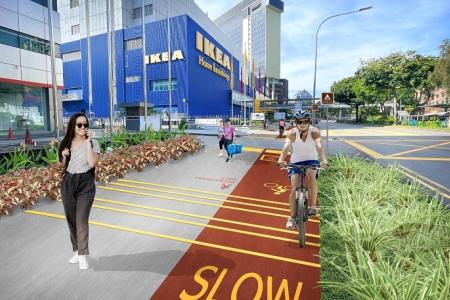60km of cycling paths to be built by 2029
Those who cycle around Bukit Merah, Bukit Timah, Kallang and the city centre will be able to ride along an additional 60km of cycling paths by 2029, with the Land Transport Authority (LTA) calling a tender on Dec 18 to build the new infrastructure.
The new paths will comprise a mix of dedicated cycling paths and shared paths, with some stretches to be sheltered from the elements.
Shared paths, which are typically marked with dotted red lines, can be used by both pedestrians and active mobility device users, including cyclists.
In response to queries, LTA said its tentative plans are to start construction of the approximately 60km of extra paths in early 2026.
The latest construction tender comes on top of 20km of cycling paths that are already being built in the same four areas to improve connectivity to schools, neighbourhood centres and transport nodes like MRT stations. The 20km of paths are estimated to be completed in December 2025.
These works will contribute to an estimated total of 150km of cycling paths in Singapore’s central region that will be ready by 2030.
Across the country, there are now more than 660km of cycling paths and park connectors. By 2030, this islandwide network is expected to span about 1,300km, so eight in 10 Housing Board residents will be within minutes of their nearest cycling path.
Under the latest LTA tender, 23km of cycling paths will be built in Bukit Merah, covering a larger portion of the HDB town.
According to tender documents seen by The Straits Times, this includes long stretches along Jalan Bukit Merah, Tiong Bahru Road, Lower Delta Road and Alexandra Road, as well as Hoy Fatt Road, Lengkok Bahru, Redhill Close and the estate in Telok Blangah Heights.
In Bukit Timah, the cycling network will expand by 11km.
A new cycling path will cover the length of Dunearn Road from Jalan Anak Bukit to Farrer Flyover, before extending southwards along Farrer Road until Leedon Heights.
New paths will also be built in Bukit Timah Road, covering stretches between Farrer Flyover and Lewis Road, and between Stevens Road and Balmoral Road.
Within the city centre, new cycling paths will be added in Tanglin, Orchard Boulevard, Cavenagh Road, Selegie, Beach Road, Raffles Boulevard and Republic Boulevard, as well as Telok Ayer, Anson and Keppel. These will add up to 16km in total.
In the Kallang area, 11km of cycling paths will be added to places like Kallang Bahru, Tessensohn Road and Tanjong Rhu.
In a Facebook post on Dec 18, LTA noted that the new paths in Bukit Timah will give cyclists easier access to the city centre in the future, as these paths will eventually connect with the upcoming North-South Corridor (NSC).
The NSC, a 21.5km transport corridor between northern Singapore and the city, will come with its own set of cycling paths and trunk routes after it is completed in phases from 2027.
Like the rest of the cycling infrastructure being built around Singapore, the new paths under the latest LTA tender will need to have a minimum width of 2m if they are dedicated cycling paths, and a minimum width of 2.5m if they are shared paths.
At least 2.5m of width must be allocated for paths that go behind bus stops, taxi stands, and pick-up and drop-off points. Mitigation measures, such as mirrors, must also be installed at locations with safety and blind spot concerns.
Over the past two years, the LTA has called multiple tenders for cycling path construction as it ramps up the pace of work.
In the west, about 34km of new cycling paths in places such as Jurong West, Bukit Batok and Clementi are in the works.
More recently in August, LTA put out a call for bids to add 87km of new cycling paths in seven towns in the east and north-east, as well as in industrial estates in Sin Ming, Bedok, Pasir Ris and Tampines. Construction will start in early 2026.
Undergraduate Ong Jia Cheng, 22, who cycles often, believes the improvements in Bukit Merah will make walking and cycling safer and more comfortable along major roads like Jalan Bukit Merah, which has only a narrow footpath now.
“If I cycle, I would prefer to avoid the footpaths there because it feels pretty hazardous to do so,” Mr Ong said, adding that this may change with the new cycling paths being added.
While he applauded plans to remove roadside parking in Telok Ayer and McCallum Street to make room for shared paths, Mr Ong said there are still critical gaps in the cycling network in the central region, such as in Chinatown, Bugis and Little India.
“This suggests that it will still be quite difficult to go across the city centre on a bicycle even in 2029,” he added.
Get The New Paper on your phone with the free TNP app. Download from the Apple App Store or Google Play Store now



